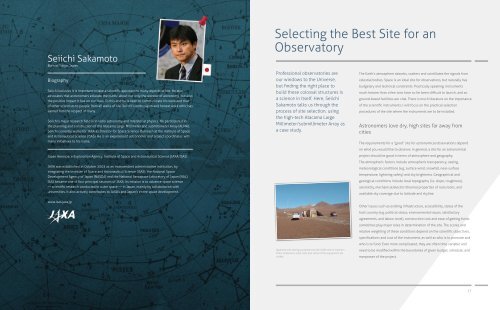Sol Lucet Omnibus - ESO
Sol Lucet Omnibus - ESO
Sol Lucet Omnibus - ESO
- TAGS
- lucet
- omnibus
- www.eso.org
Create successful ePaper yourself
Turn your PDF publications into a flip-book with our unique Google optimized e-Paper software.
Seiichi Sakamoto<br />
Born in Tokyo, Japan<br />
Biography<br />
Seiichi believes it is important to take a scientific approach to many aspects of life. He also<br />
advocates that astronomers educate the public about not only the wonder of astronomy, but also<br />
the positive impact it has on our lives. To this end he is keen to communicate his work and that<br />
of other scientists to people from all walks of life. Seiichi’s enthusiasm and honest work ethic has<br />
earned him the respect of many.<br />
Seiichi’s major research field is in radio astronomy and interstellar physics. He participated in<br />
the planning and construction of the Atacama Large Millimeter and submillimeter Array (ALMA).<br />
Seiichi currently works for JAXA as Director for Space Science Outreach at the Institute of Space<br />
and Astronautical Science (ISAS). He is an experienced astronomer and project coordinator, with<br />
many initiatives to his name.<br />
Japan Aerospace Exploration Agency, Institute of Space and Astronautical Science (JAXA/ISAS)<br />
JAXA was established in October 2003 as an independent administrative institution, by<br />
integrating the Institute of Space and Astronautical Science (ISAS), the National Space<br />
Development Agency of Japan (NASDA) and the National Aerospace Laboratory of Japan (NAL).<br />
ISAS became one of four principal sections of JAXA. Its mission is to advance space science<br />
— scientific research conducted in outer space — in Japan, mainly by collaboration with<br />
universities. It also actively contributes to JAXA’s and Japan’s entire space development.<br />
www.isas.jaxa.jp<br />
Selecting the Best Site for an<br />
Observatory<br />
Professional observatories are<br />
our windows to the Universe,<br />
but finding the right place to<br />
build these colossal structures is<br />
a science in itself. Here, Seiichi<br />
Sakamoto talks us through the<br />
process of site selection, using<br />
the high-tech Atacama Large<br />
Millimeter/submillimeter Array as<br />
a case study.<br />
Japanese site-testing equipment at the ALMA site in northern<br />
Chile. Containers, solar cells and some of the equipment are<br />
visible.<br />
The Earth’s atmosphere absorbs, scatters and scintillates the signals from<br />
celestial bodies. Space is an ideal site for observations, but naturally has<br />
budgetary and technical constraints. Practically speaking, instruments<br />
much heavier than a few tons have so far been difficult to launch, and so<br />
ground-based facilities are vital. There is much literature on the importance<br />
of the scientific instruments; I will focus on the practical selection<br />
procedures of the site where the instruments are to be installed.<br />
Astronomers love dry, high sites far away from<br />
cities<br />
The requirements for a “good” site for astronomical observations depend<br />
on what you would like to observe. In general, a site for an astronomical<br />
project should be good in terms of atmosphere and geography.<br />
The atmospheric factors include atmospheric transparency, seeing,<br />
meteorological conditions (e.g. surface wind, snowfall, near-surface<br />
temperature, lightning safety) and sky brightness. Geographical and<br />
geological conditions include local topography (i.e. slope, roughness),<br />
seismicity, mechanical/electric/thermal properties of rocks/soils, and<br />
available sky coverage due to latitude and skyline.<br />
Other issues such as existing infrastructure, accessibility, status of the<br />
host country (e.g. political status, environmental issues, satisfactory<br />
agreements, and labour level), construction cost and ease of getting funds<br />
sometimes play major roles in determination of the site. The scores and<br />
relative weighting of these conditions depend on the scientific objectives,<br />
specifications and cost of the instrument, as well as who is to promote and<br />
who is to fund. Even more complicated, they are often time variable and<br />
need to be modified within the boundaries of given budget, schedule, and<br />
manpower of the project.<br />
17

















